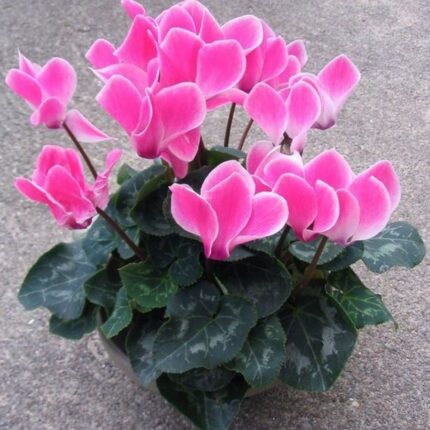The Primula, commonly known as Primrose, is a delightful flowering plant celebrated for its vibrant and colorful blooms. Its striking flowers come in a spectrum of colors, including pink, purple, red, yellow, and white, creating a cheerful and eye-catching display. The plant forms a rosette of lush, green leaves, which provide an attractive base for the colorful flowers that emerge in early spring.
Key Features:
- Colorful Blooms: Primula flowers are renowned for their bright, multi-colored petals that bring a burst of color to gardens and indoor arrangements. They typically appear in clusters, creating a dense and visually appealing floral display.
- Attractive Foliage: The plant’s rosette of green, often crinkled leaves complements the vibrant flowers, enhancing the overall aesthetic appeal.
- Seasonal Interest: Primula is primarily a spring-blooming plant, offering early-season color when many other plants are just starting to awaken.
Optimal Growing Conditions:
- Light: Primula thrives in partial shade to full shade, making it an excellent choice for brightening up shaded areas or indoor spaces with indirect light.
- Soil: It prefers cool, moist, and well-draining soil enriched with organic matter. A slightly acidic to neutral pH is ideal.
- Temperature: Primula enjoys cooler temperatures, typically between 50-65°F (10-18°C). It can struggle in high heat, so providing shade during hot weather is beneficial.
Care Instructions:
- Watering: Keep the soil consistently moist but not waterlogged. Primula prefers regular watering to maintain its vibrant blooms, but ensure proper drainage to prevent root rot.
- Fertilization: Feed the plant with a balanced, water-soluble fertilizer every 4-6 weeks during the growing season to support healthy growth and abundant flowering.
- Deadheading: Remove spent flowers to encourage continuous blooming and prevent the plant from going to seed.
Propagation:
Primula can be propagated through seeds or division. Sow seeds in early spring or divide established clumps in the fall to create new plants.
Common Issues:
- Pests: Watch for pests like aphids and slugs. Treat them with appropriate insecticides or natural remedies.
- Diseases: Avoid overcrowding and ensure good air circulation to prevent fungal diseases such as powdery mildew and root rot.
Conclusion:
Primula is a versatile and charming plant that adds a burst of color to gardens and indoor spaces. With its bright blooms, attractive foliage, and preference for cool, moist conditions, it’s perfect for enhancing shaded areas and springtime floral displays. By providing the right care and growing conditions, you can enjoy the beauty and vibrancy of Primula throughout its blooming season.










Reviews
There are no reviews yet.